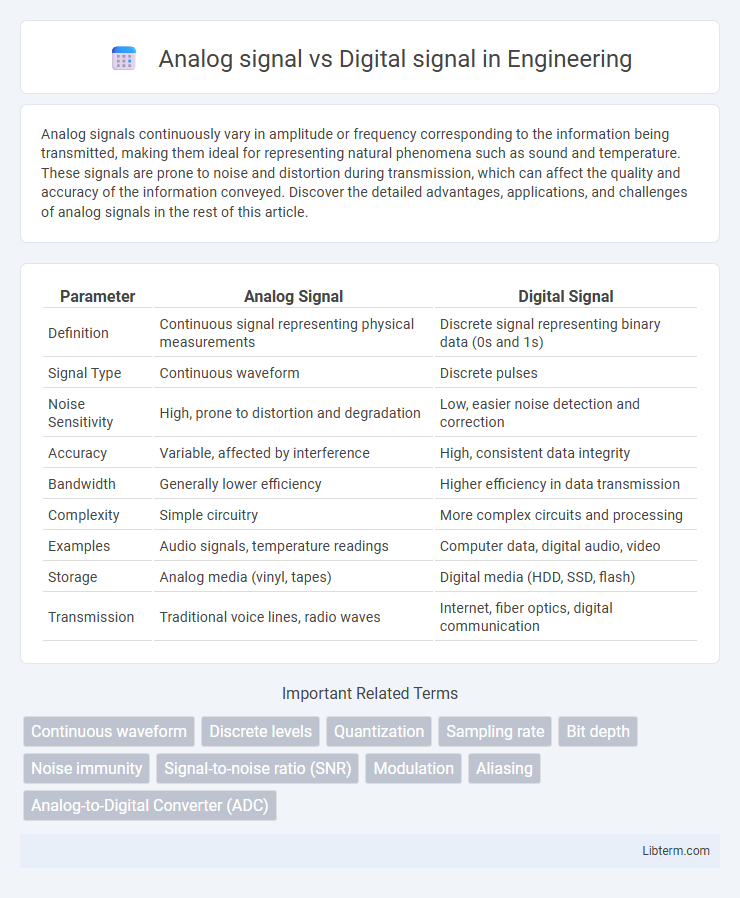Analog signals continuously vary in amplitude or frequency corresponding to the information being transmitted, making them ideal for representing natural phenomena such as sound and temperature. These signals are prone to noise and distortion during transmission, which can affect the quality and accuracy of the information conveyed. Discover the detailed advantages, applications, and challenges of analog signals in the rest of this article.
Table of Comparison
| Parameter | Analog Signal | Digital Signal |
|---|---|---|
| Definition | Continuous signal representing physical measurements | Discrete signal representing binary data (0s and 1s) |
| Signal Type | Continuous waveform | Discrete pulses |
| Noise Sensitivity | High, prone to distortion and degradation | Low, easier noise detection and correction |
| Accuracy | Variable, affected by interference | High, consistent data integrity |
| Bandwidth | Generally lower efficiency | Higher efficiency in data transmission |
| Complexity | Simple circuitry | More complex circuits and processing |
| Examples | Audio signals, temperature readings | Computer data, digital audio, video |
| Storage | Analog media (vinyl, tapes) | Digital media (HDD, SSD, flash) |
| Transmission | Traditional voice lines, radio waves | Internet, fiber optics, digital communication |
Introduction to Analog and Digital Signals
Analog signals represent continuous waveforms that vary smoothly over time, capturing real-world phenomena such as sound, temperature, and light intensity with infinite resolution. Digital signals encode information as discrete binary values, enabling robust data processing, storage, and transmission in computers and modern communication systems. Understanding the fundamental differences between analog and digital signals is crucial for applications in electronics, telecommunications, and signal processing technologies.
Defining Analog Signals
Analog signals represent continuous waveforms that vary smoothly over time, capturing real-world phenomena such as sound, light, and temperature. These signals convey information through variations in amplitude, frequency, or phase, maintaining an infinite range of possible values within a given interval. Unlike digital signals, which use discrete levels, analog signals are prone to noise and distortion but excel in accurately representing natural analog sources.
Defining Digital Signals
Digital signals represent information using discrete binary values, typically 0s and 1s, enabling precise and noise-resistant data transmission. Unlike analog signals, which vary continuously over a range of values, digital signals maintain consistent amplitude levels that simplify signal processing and error correction. The binary nature of digital signals allows for efficient encoding, storage, and reliable communication in modern electronics and computing systems.
Key Differences Between Analog and Digital Signals
Analog signals represent continuous waveforms that vary smoothly over time, capturing infinite variations in amplitude and frequency, while digital signals encode information as discrete binary values, typically 0s and 1s. Analog signals are susceptible to noise and distortion, which degrade the signal quality, whereas digital signals offer improved noise immunity and easier error detection through binary encoding. The key differences include signal representation, noise sensitivity, and data processing methods, with analog signals favored for natural, real-world signal capture and digital signals preferred for computational efficiency and transmission robustness.
Advantages of Analog Signals
Analog signals provide continuous data representation, offering higher resolution and more accurate capture of real-world phenomena such as sound and temperature fluctuations. They are less prone to quantization errors, ensuring smooth and natural signal variations without the sampling limitations seen in digital systems. Analog systems often require simpler circuitry and can be more cost-effective for specific applications like audio amplification and sensor data collection.
Advantages of Digital Signals
Digital signals offer enhanced noise resistance, ensuring clearer and more reliable transmission compared to analog signals. They enable easier data compression, storage, and encryption, improving efficiency and security in communication systems. Furthermore, digital signals facilitate error detection and correction, increasing the overall accuracy and integrity of transmitted information.
Disadvantages of Analog Signals
Analog signals are highly susceptible to noise and distortion during transmission, which can degrade the quality and accuracy of the data. They have limited flexibility in processing and storage compared to digital signals, making them less efficient for modern communication systems. Furthermore, analog signals are more challenging to encrypt, posing higher security risks in sensitive applications.
Disadvantages of Digital Signals
Digital signals face challenges due to their susceptibility to quantization errors and limited resolution, which can degrade signal quality in certain applications. They require complex encoding and decoding processes, increasing system cost and power consumption compared to analog signals. Moreover, digital signals can suffer from latency issues in real-time processing scenarios, impacting performance in critical communication systems.
Real-World Applications of Analog and Digital Signals
Analog signals are widely used in real-world applications such as audio recording, radio broadcasting, and temperature measurement where continuous signal variation is essential for accuracy. Digital signals dominate in communication systems, computing, and data storage due to their noise resistance and ease of processing. Hybrid technologies leverage both analog and digital signals in medical imaging and telecommunications to optimize performance and reliability.
Conclusion: Which is Better for Modern Use?
Digital signals offer superior noise resistance and easier integration with modern computing systems, making them preferable for most contemporary applications. Analog signals, while providing continuous data representation, suffer more from degradation and are less compatible with digital processing technologies. The shift towards digital communication and storage highlights digital signals as the better choice for efficiency, scalability, and accuracy in modern use.
Analog signal Infographic

 libterm.com
libterm.com